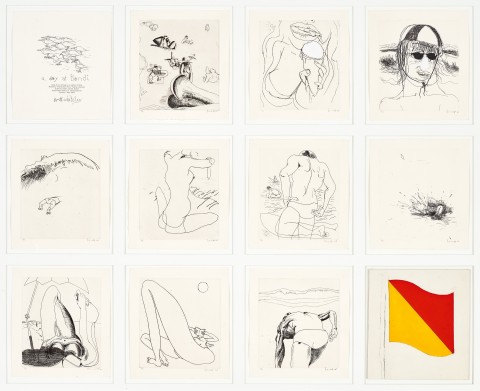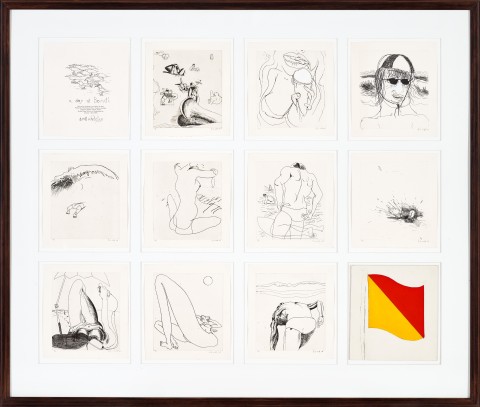A DAY AT BONDI, 1984
BRETT WHITELEY
etching and collage on paper
20.0 x 18.0 cm (image, each)
24.0 x 22.0 cm (sheet, each)
104.5 x 123.5 cm (framed overall)
each signed and numbered below image
suite of ten etchings plus title page and collaged flag
Private collection, Sydney
Richard Martin Art, Sydney
Private collection, Sydney
Mandy, R., Brett Whiteley: Graphics 1961 - 1982, Art Gallery of Western Australia, Perth, 1983, cat. 83 – 93, pp. 66 – 68 (illus., another example).
Brett Whiteley: The Graphics 1961 – 1992, Deutscher Fine Art, Melbourne, 1992, cats. 76 – 86, pp. 79 – 83 (illus., another example), 114
Sutherland, K., Brett Whiteley: Catalogue Raisonné, Schwartz Publishing, Melbourne, 2020, cats. 132P – 142P, vol. 5,
pp. 160 – 161; 163; 165 – 169; 171 – 175 (illus., another example), vol. 7, pp. 836 – 837
Sydney’s iconic sandy playground, Bondi Beach, was a recurrent motif in Brett Whiteley’s work – the perfect outdoor backdrop for his buxom and supple figures, caught in intimate moments of relaxation and performative athletic activity. A day at Bondi, 1984 is a suite of ten black and white etchings, arranged in a storyboard sequence of a summer’s day well spent by the sea, accompanied by a title page adorned with a squabble of seagulls, and a unique collaged flag. For Whiteley, printmaking was a natural extension of his painting and drawing practice, expanding on the same motifs and often including original and unique additions (such as the collaged flag in this sequence). Several large paintings later derived from the same scenes depicted in A day at Bondi, including the lifesaver in The Lebanese grin – Bondi, 1986 and Diving in, Bondi, 1988. ‘I am not interested in the Marxist side of printmaking… cheaper originals. A good print should have the same feeling of “rightness” that a one-off drawing should have’, Whiteley explained in a handwritten text A few words about printmaking in December of 1982.1
Reproducing the immediacy of in-situ sketches within Whiteley’s notebooks, the prints of A day at Bondi express recognisable actions in just a few assured lines. With only minimal visual references to the landscape, Whiteley’s etchings of A day at Bondi are dominated by two archetypal avatars of the beach: a female topless sunbather, her lassitude counterbalanced by a strutting, athletic surf lifesaver. These figures encapsulate the zeitgeist of 1980s hedonism – the age of topless bathing and portable cassette players. Each displays in various vignettes the joie de vivre of a day at the beach: licking a dripping ice cream cone, diving cleanly underneath a dumping wave, reading a burning-hot paperback held up against the sun, or balancing carefully on a swaying surfboard. While printed in simple black and white, we implicitly understand the vibrancy of the colours perceived by the artist – the iconic red-and-yellow swimming cap, bronzed bodies and ultramarine water. All drawn with the simple gestural elegance of Whiteley’s acclaimed draughtsmanship, these etchings are spare and almost caricatural. They emphasise the sensuous arabesques of relaxed and reclining bodies, rippling muscles, and awkward contortions of crouched forms. In the bleaching, blinding sun of a Sydney summer, these figures are flooded with light, their forms almost entirely devoid of modelling and shadow.
Painting and drawing Australia’s glittering, busy shore with the ceaseless wonderment of a returned expatriate, Whiteley’s works exhibit an almost childlike excitement and whimsy, emphasised by the handwritten title. Bondi beach, although explicitly referenced in the title of this work, is only obliquely referenced in certain plates – a long wave bisecting the image with five minimal lines, a radiant sun minimally drawn with a simple circle in an otherwise featureless landscape.
1. ‘Introductory note’, Brett Whiteley: The Complete Graphics, Art Gallery of Western Australia, Perth, 1983
LUCIE REEVES-SMITH


